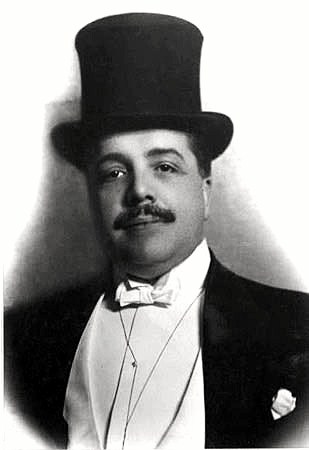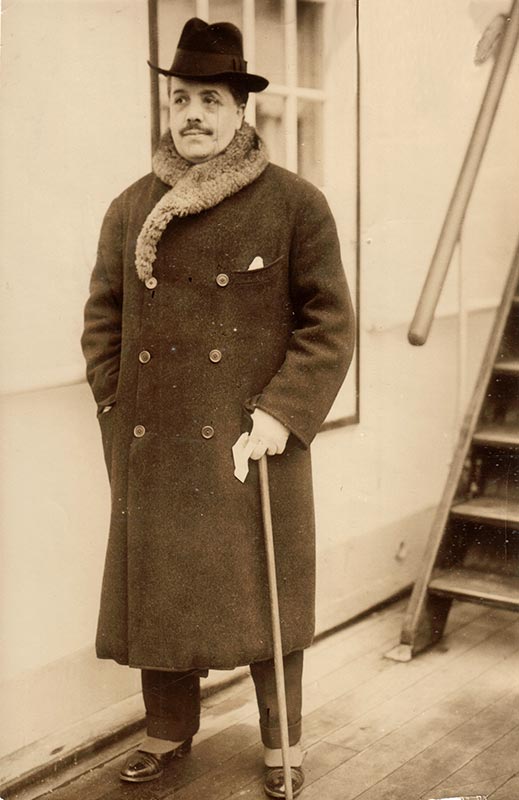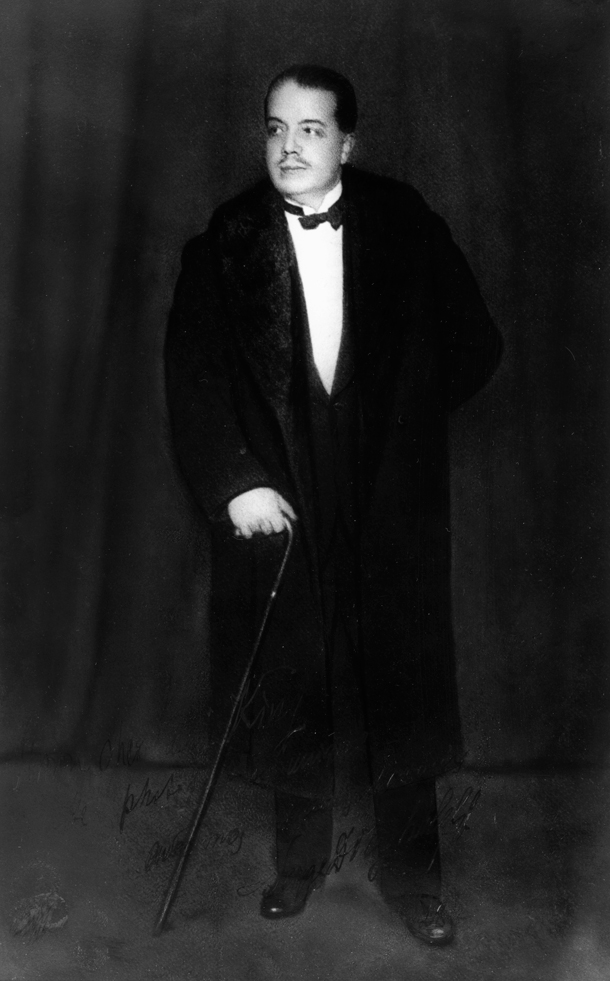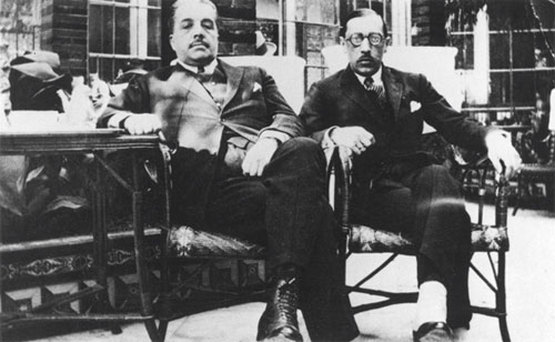<Back to Index>
- Ballet Impresario and Critic Sergei Pavlovich Diaghilev, 1872
PAGE SPONSOR



Sergei Pavlovich Diaghilev (Russian: Серге́й Па́влович Дя́гилев, Sergei Pavlovich Dyagilev; 31 March [O.S. 19 March] 1872 – 19 August 1929), usually referred to outside of Russia as Serge, was a Russian art critic, patron, ballet impresario and founder of the Ballets Russes, from which many famous dancers and choreographers would arise.
Sergei Diaghilev was born to a wealthy and cultured family in Selischi (Novgorod Governorate), Russia; his father, Pavel Pavlovich, was a cavalry colonel, but the family's money came mainly from vodka distilleries. After the death of Sergei's mother, his father married Elena Valerianovna Panaeva, an artistic young woman who was on very affectionate terms with her stepson and was a strong influence on him. The family lived in Perm but had an apartment in Saint Petersburg and a country estate in Bikbarda (near Perm). In 1890, Sergei's parents went bankrupt, having for a long time lived beyond their means, and from that time Sergei (who had a small income inherited from his mother) had to support the family. After graduating from Perm gymnasium in 1890, he went to the capital to study law at St. Petersburg University, but ended up also taking classes at the St. Petersburg Conservatory of Music, where he studied singing and music (a love of which he had picked up from his stepmother). After graduating in 1892 he abandoned his dreams of composition (his professor, Nikolai Rimsky - Korsakov, told him he had no talent for music). He had already entered an influential circle of artists who called themselves the Mir iskusstva: Alexandre Benois, Walter Nouvel, Konstantin Somov, Dmitry Filosofov and Léon Bakst. Although not instantly received into the group, Diaghilev was aided by Benois in developing his knowledge of Russian and Western art. In two years, he had voraciously absorbed this new obsession (even traveling abroad to further his studies) and came to be respected as one of the most learned of the group.
With financial backing from Savva Mamontov (the director of the Russian Private Opera Company) and Princess Maria Tenisheva, the group founded the journal Mir iskusstva (World of Art). In 1899, Diaghilev became special assistant to Prince Sergei Mikhaylovich Volkonsky, who had recently taken over directorship of all Imperial theaters. Diaghilev was soon responsible for the production of the Annual of the Imperial Theaters in 1900, and promptly offered assignments to his close friends: Léon Bakst would design costumes for the French play Le Coeur de la Marquise, while Benois was given the opportunity to produce Sergei Taneyev's opera Cupid's Revenge.
In 1900 – 1901 Volkonsky entrusted Diaghilev with the staging of Léo Delibes' ballet Sylvia, a favorite of Benois. The two collaborators concocted an elaborate production plan that startled the established personnel of the Imperial Theaters. After several increasingly antagonistic differences of opinion, Diaghilev in his demonstrative manner refused to go on editing the "Annual of the Imperial Theaters" and was discharged by Volkonsky in 1901 and left disgraced in the eyes of the nobility. At the same time, some of Diaghilev's researchers hinted at his homosexuality as the main cause for this conflict. However, his homosexuality had been well known long before he was invited into the Imperial Theaters and so it could not be the real reason for his being discharged.
Diaghilev's friends stayed true, following him and helping to put on exhibitions, mounted in the name of Mir iskusstva. In 1905 he mounted a huge exhibition of Russian portrait painting in St Petersburg, having traveled widely through Russia for a year discovering many previously unknown masterpieces of Russian portrait art. In the following year he took a major exhibition of Russian art to the Petit Palais in Paris. It was the beginning of a long involvement with France. In 1907 he presented five concerts of Russian music in Paris, and in 1908 mounted a production of Boris Godunov, starring Feodor Chaliapin, at the Paris Opera.
This led to an invitation to return the following year with ballet as well as opera, and thus to the launching of his famous Ballets Russes. The company included the best young Russian dancers, among them Anna Pavlova, Adolph Bolm, Vaslav Nijinsky, Tamara Karsavina and Vera Karalli, and their first night on 19 May 1909 was a sensation.
During these years Diaghilev's stagings included several compositions by the late Nikolai Rimsky - Korsakov, such as the operas The Maid of Pskov, May Night and The Golden Cockerel. His balletic adaptation of the orchestral suite Sheherazade, staged in 1910, drew the ire of the composer's widow, Nadezhda Rimskaya - Korsakova, who protested in open letters to Diaghilev published in the periodical Rech. Diaghilev commissioned ballet music from composers such as Nikolai Tcherepnin (Narcisse et Echo, 1911), Claude Debussy (Jeux, 1913), Maurice Ravel (Daphnis et Chloé, 1912), Erik Satie (Parade, 1917), Manuel de Falla (El Sombrero de Tres Picos, 1917), Richard Strauss (Josephslegende, 1914), Sergei Prokofiev (Ala and Lolly, rejected by Diaghilev and turned into the Scythian Suite; Chout, 1915 revised 1920; Le pas d'acier, 1926; and The Prodigal Son, 1929), Ottorino Respighi (La Boutique fantasque, 1918), Francis Poulenc (Les biches, 1923) and others. His choreographer Michel Fokine often adapted the music for ballet. Diaghilev also worked with dancer and ballet master Léonide Massine.
The artistic director for the Ballets Russes was Léon Bakst. Together they developed a more complicated form of ballet with show - elements intended to appeal to the general public, rather than solely the aristocracy. The exotic appeal of the Ballets Russes had an effect on Fauvist painters and the nascent Art Deco style.
Perhaps Diaghilev's most notable composer - collaborator, however, was Igor Stravinsky. Diaghilev heard Stravinsky's early orchestral works Fireworks and Scherzo fantastique, and was impressed enough to ask Stravinsky to arrange some pieces by Chopin for the Ballets Russes. In 1910, he commissioned his first score from Stravinsky, The Firebird. Petrushka (1911) and The Rite of Spring (1913) followed shortly afterwards, and the two also worked together on Pulcinella (1920) and Les noces (1923).
After the Russian Revolution of 1917, Diaghilev stayed abroad. The new Soviet regime, once it became obvious that he could not be lured back, condemned him in perpetuity as an especially insidious example of bourgeois decadence. Soviet art historians wrote him out of the picture for more than 60 years.
Diaghilev staged Tchaikovsky's The Sleeping Beauty in London in 1921; it was a production of remarkable magnificence both in settings and costumes but, despite being well received by the public, it was a financial disaster for Diaghilev and Oswald Stoll, the theater owner who had backed it. The first cast included the legendary ballerina Olga Spessivtseva and Lubov Egorova in the role of Aurora. Diaghilev insisted on calling the ballet The Sleeping Princess. When asked why, he quipped, "Because I have no beauties!" The later years of the Ballets Russes were often considered too "intellectual", too "stylish" and seldom had the unconditional success of the first few seasons, although younger choreographers like George Balanchine hit their stride with the Ballet Russes.
The end of the 19th century brought a development in the handling of tonality, harmony, rhythm and meter towards more freedom. Until that time, rigid harmonic schemes had forced rhythmic patterns to stay fairly uncomplicated. Around the turn of the century, however, harmonic and metric devices became either more rigid, or much more unpredictable, and each approach had a liberating effect on rhythm, which also affected ballet. Diaghilev was a pioneer in adapting these new musical styles to modern ballet. When Ravel used a 5/4 time in the final part of his ballet Daphnis and Chloe (1912), dancers of the Ballets Russes sang Ser - ge - dia - ghi - lev during rehearsals to keep the correct rhythm.
Members of Diaghilev's Ballets Russes later went on to found ballet traditions in the United States (George Balanchine) and England (Ninette de Valois and Marie Rambert). Ballet master Serge Lifar went on a technical revival at the Paris Opera Ballet, enhanced by Claude Bessy and Rudolf Nureyev in the 1980s. Lifar is credited for saving many Jewish and other minority dancers from the Nazi concentration camps during World War II.
Nijinsky's later bitter comments about Diaghilev inspired a mention in W.H. Auden's poem "September 1, 1939": "The windiest militant trash/ Important Persons shout/ Is not so crude as our wish:/ What mad Nijinsky wrote/ About Diaghilev/ Is true of the normal heart;/ For the error bred in the bone/ Of each woman and each man/ Craves what it cannot have, Not universal love/ But to be loved alone."
Diaghilev was known as a hard, demanding, even frightening taskmaster. Ninette de Valois, no shrinking violet, said she was too afraid to ever look him in the face. George Balanchine said he carried around a cane during rehearsals, and banged it angrily when he was displeased. Other dancers said he would shoot them down with one look, or a cold comment. On the other hand, he was capable of great kindness, and when stranded with his bankrupt company in Spain during the 1914 - 18 war, gave his last bit of cash to Lydia Sokolova to buy medical care for her daughter. Alicia Markova was very young when she joined the Ballet Russes and would later say that she had called Diaghilev "Sergypops" and he'd said he would take care of her like a daughter.
Diaghilev dismissed Nijinsky summarily from the Ballets Russes after the dancer's marriage in 1913. Nijinsky appeared again with the company, but the old relationship between the men was never re-established; moreover, Nijinsky's magic as a dancer was much diminished by incipient madness. Their last meeting was after Nijinsky's mind had given way, and he appeared not to recognize his former lover. Dancers such as Alicia Markova, Tamara Karsavina, Serge Lifar, and Lydia Sokolova remembered Diaghilev fondly, as a stern but kind father figure who put the needs of his dancers and company above his own. He lived from paycheck to paycheck to finance his company, and though he spent considerable amounts of money on a splendid collection of rare books at the end of his life, many people noticed that his impeccably cut suits had frayed cuffs and trouser ends. The film The Red Shoes is a thinly disguised dramatization of the Ballet Russes.
Throughout his life, Diaghilev was severely afraid of dying in water, and avoided traveling by boat. He died of diabetes in Venice on 19 August 1929, and is buried on the nearby island of San Michele.
The Ekstrom Collection of the Diaghilev and Stravinsky Foundation is held by the Department of Theatre and Performance of the Victoria and Albert Museum.
